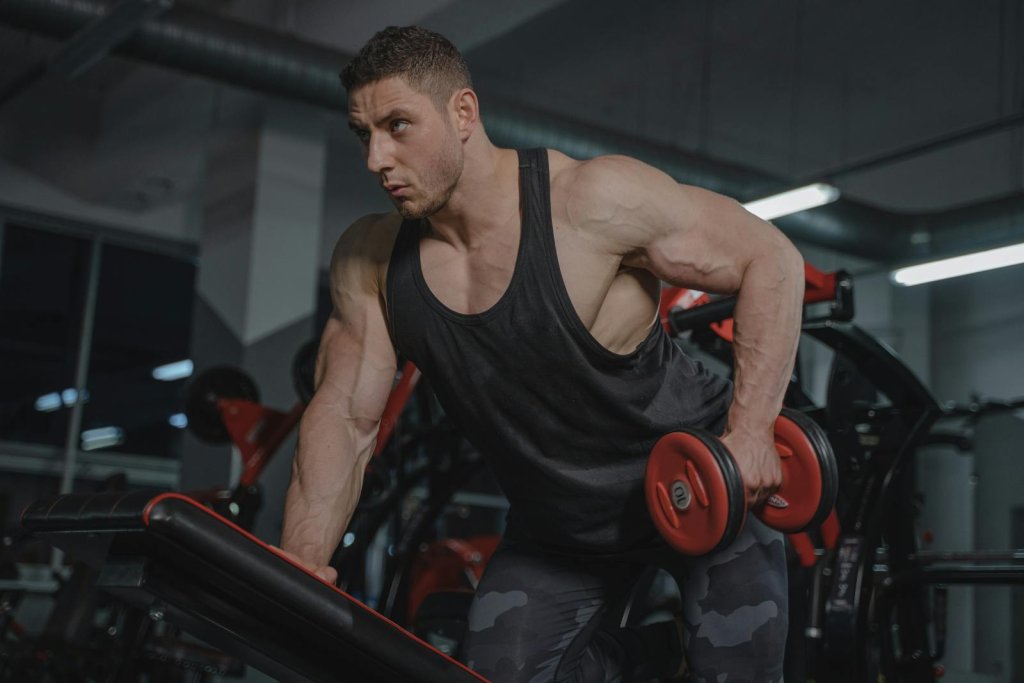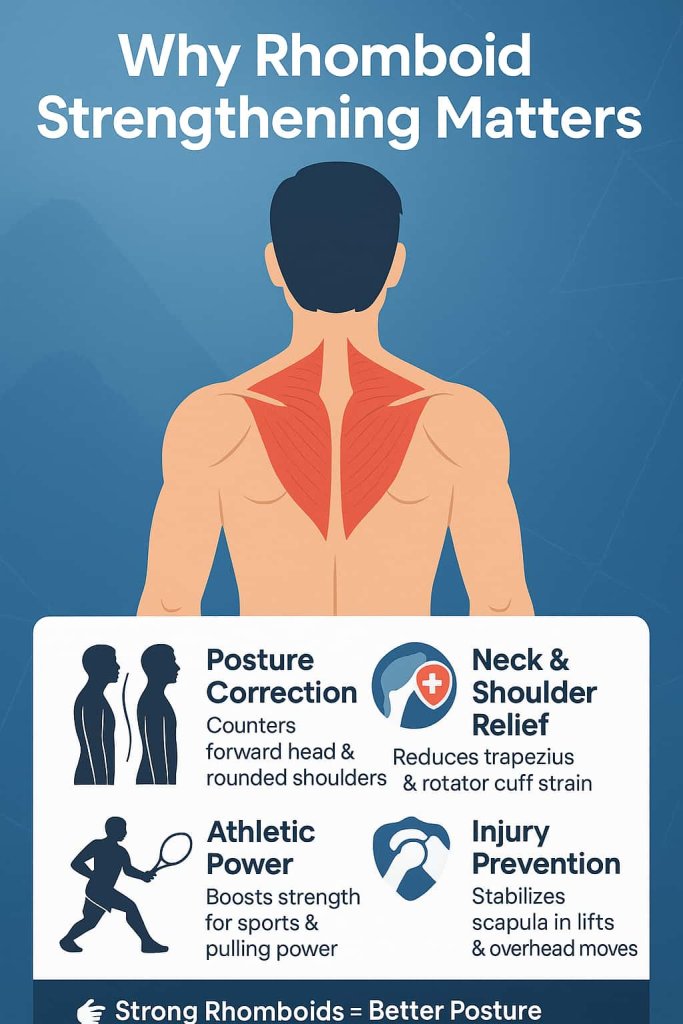Yes—rhomboid exercises are one of the best ways to fix posture and strengthen your upper back. The rhomboid muscles (rhomboid major and minor) lie between your shoulder blades and spine. They are responsible for scapular retraction (pulling your shoulder blades together), which keeps your shoulders stable and aligned.

When rhomboids are weak, you’ll notice rounded shoulders, neck tension, and poor posture—common problems in our screen-heavy lifestyles. Training them regularly can:
- Reduce back and neck pain
- Correct hunched posture
- Improve shoulder stability
- Support lifts, rows, and overhead movements
This guide covers 15 proven rhomboid exercises using bands, bodyweight, dumbbells, barbells, and cables—suitable for beginners to advanced lifters.
Why Rhomboid Strengthening Matters
The rhomboids are stabilizers, not movers—but without them, your upper body strength and posture collapse. The main benefits include:

- Posture Correction → counters forward head and rounded shoulders.
- Neck & Shoulder Relief → reduces pressure on trapezius and rotator cuff.
- Athletic Power → improves pulling strength in rowing, swimming, tennis, and golf.
- Injury Prevention → stabilizes scapula during pressing and overhead lifts.
- Aesthetics → builds a thicker, more balanced upper back.
15 Best Rhomboid Exercises
Here are the 15 best rhomboid exercises—from bands to barbells to bodyweight—that will help you build strength, stability, and posture.
1. Band Pull-Aparts
How to Do It:
- Hold a resistance band at shoulder height with straight arms.
- Pull the band apart by squeezing your shoulder blades together.
- Slowly return to the start.
Muscles Worked: Rhomboids, rear delts, mid-traps.
Trainer Tip: Keep arms parallel to the floor—avoid shrugging.
Why It Works: Simple, scalable, and effective for correcting rounded shoulders.
2. Low-to-High Band Rows
How to Do It:
- Anchor a band low to the ground.
- Pull diagonally upward toward chest height.
- Focus on squeezing shoulder blades together.
Muscles Worked: Rhomboids, lats, traps.
Trainer Tip: Align your pull with your rhomboid fibers—low to high.
Why It Works: Mimics the natural pulling angle of rhomboids.
3. Scapular Wall Slides
How to Do It:
- Stand with back against the wall, arms bent at 90°.
- Keep elbows and wrists in contact with the wall.
- Slowly slide arms upward, then return.
Muscles Worked: Rhomboids, rotator cuff, mid-traps.
Trainer Tip: Keep lower back flat to avoid arching.
Why It Works: Excellent corrective move for posture and shoulder mobility.
4. Scapular Retractions (Band or Bodyweight)
How to Do It:
- Anchor a band or use a suspension trainer.
- Without bending elbows, pull shoulder blades back and down.
- Return with control.
Muscles Worked: Rhomboids, traps, serratus anterior.
Trainer Tip: Think of “pinching a pencil” between your shoulder blades.
Why It Works: Builds scapular awareness, crucial for posture correction.
5. Scapular Pull-Ups
How to Do It:
- Hang from a pull-up bar.
- Shrug shoulders down and back, without bending arms.
- Slowly relax and repeat.
Muscles Worked: Rhomboids, lats, traps.
Trainer Tip: Keep movement small and controlled.
Why It Works: Pure isolation for rhomboids in a bodyweight form.
6. I-Y-T Raises
How to Do It:
- Lie chest-down on a bench or mat.
- Raise arms straight overhead (“I”), out at 45° (“Y”), and to the side (“T”).
- Hold each position briefly.
Muscles Worked: Rhomboids, rear delts, mid/lower traps.
Trainer Tip: Use light weights or bodyweight—focus on quality, not load.
Why It Works: Activates upper back muscles across multiple planes.
7. Batwing Rows
How to Do It:
- Lie chest-down on an incline bench.
- Row dumbbells toward ribs while holding scapular retraction.
- Pause, then lower slowly.
Muscles Worked: Rhomboids, rear delts, traps.
Trainer Tip: Keep elbows tight to the body—avoid flaring.
Why It Works: Combines row strength with scapular stability.
8. Single-Arm Dumbbell Row
How to Do It:
- Place one knee and hand on a bench, holding dumbbell in the other hand.
- Row toward your hip while squeezing shoulder blade.
- Lower with control.
Muscles Worked: Rhomboids, lats, traps.
Trainer Tip: Pull to your hip, not chest, to better activate rhomboids.
Why It Works: Prevents imbalances with unilateral strength focus.
9. Bent-Over Barbell Row
How to Do It:
- Hold barbell, hinge at hips until torso is almost parallel to floor.
- Row bar toward belly while retracting shoulder blades.
- Lower under control.
Muscles Worked: Rhomboids, lats, erector spinae.
Trainer Tip: Keep back flat and core braced—avoid rounding.
Why It Works: A powerhouse compound lift that develops rhomboids and overall back.
10. Inverted Row
How to Do It:
- Set bar at waist height, body underneath.
- Pull chest to bar while squeezing shoulder blades.
- Lower back down with control.
Muscles Worked: Rhomboids, traps, rear delts.
Trainer Tip: Keep body in a straight line—don’t sag at hips.
Why It Works: Great bodyweight-friendly option for posture building.
11. Cable Seated Row
How to Do It:
- Sit with feet braced and grab a cable handle.
- Row handle toward torso, retracting shoulder blades.
- Return with control.
Muscles Worked: Rhomboids, lats, traps.
Trainer Tip: Keep chest up—avoid leaning too far back.
Why It Works: Controlled tension makes it perfect for rhomboid hypertrophy.
12. Cable Reverse Fly
How to Do It:
- Set cables at chest height, arms slightly bent.
- Fly arms outward until shoulder blades pinch.
- Return slowly.
Muscles Worked: Rhomboids, rear delts, traps.
Trainer Tip: Don’t use momentum—keep it slow and strict.
Why It Works: One of the best isolation exercises for rhomboids.
13. Low-to-High Cable Rows
How to Do It:
- Anchor cable low.
- Pull diagonally upward toward upper chest.
- Focus on scapular retraction.
Muscles Worked: Rhomboids, traps, lats.
Trainer Tip: Keep core braced to avoid twisting.
Why It Works: Cable control enhances resistance in rhomboid’s pulling angle.
14. Bear Crawl
How to Do It:
- Start on all fours, knees hovering off ground.
- Crawl forward, keeping back flat and core tight.
Muscles Worked: Rhomboids, traps, core, shoulders.
Trainer Tip: Keep steps small to maintain tension.
Why It Works: Builds scapular stability while engaging the entire core.
15. Plank with Arm Rotation (Thread-the-Needle)
How to Do It:
- Start in forearm plank.
- Rotate one arm under your torso, then open and reach overhead.
- Alternate sides.
Muscles Worked: Rhomboids, obliques, traps.
Trainer Tip: Move slowly—avoid letting hips twist too much.
Why It Works: Combines core stability with dynamic rhomboid activation.
How to Add Rhomboid Training into Your Routine
- Frequency: 2–3 sessions per week
- Sets & Reps: 3–4 sets of 12–15 reps for posture, 8–12 reps for strength
- Warm-Up: Band pull-aparts, wall slides before lifting
- Workout Placement: Add to back or shoulder day
- Progression: Start with bodyweight/bands → add dumbbells/cables → build to barbell rows
Benefits of Rhomboid Training
- Better Posture: Counters hunching from long sitting hours.
- Stronger Pulling Power: Essential for pull-ups, rows, and deadlifts.
- Shoulder Health: Stabilizes rotator cuff and reduces risk of impingement.
- Neck Relief: Offloads tension from overworked traps.
- Functional Movement: Improves daily lifting, carrying, and athletic performance.
Common Mistakes to Avoid
- Shrugging shoulders: Overuses traps, not rhomboids.
- Arching lower back: Keep core engaged.
- Using momentum: Slow, controlled reps ensure activation.
- Neglecting posture work: Rhomboids should balance chest/pressing exercises.
FAQs About Rhomboid Exercises
1. What causes weak rhomboids?
Poor posture, sitting long hours, and too much pressing without pulling exercises.
2. Can I fix rounded shoulders with rhomboid training?
Yes—combine rhomboid exercises with chest stretching for best results.
3. Do push-ups train rhomboids?
Not directly. Try scapular push-ups for rhomboid activation.
4. Which exercise is best for beginners?
Start with band pull-aparts and wall slides—low risk, high reward.
5. How long until posture improves?
With consistent training, 4–6 weeks can show noticeable changes.
6. Should I use heavy weights?
Focus on form and scapular control. Moderate loads are better than heavy, sloppy reps.
7. Are rhomboid exercises safe for shoulder injuries?
Yes, but start with band-based moves. Consult a physiotherapist if pain persists.
Conclusion
Your rhomboids may be small, but they’re critical for posture, strength, and pain-free shoulders. By practicing these 15 rhomboid exercises consistently, you’ll build a stronger upper back, correct slouching, and perform better in both gym and daily life.
👉 Start today with band pull-aparts and wall slides, then progress to rows and flys for maximum back strength. A healthier posture begins with strong rhomboids!
